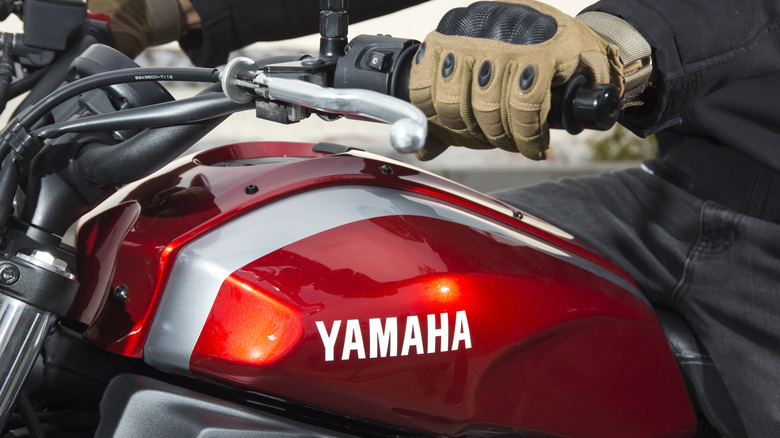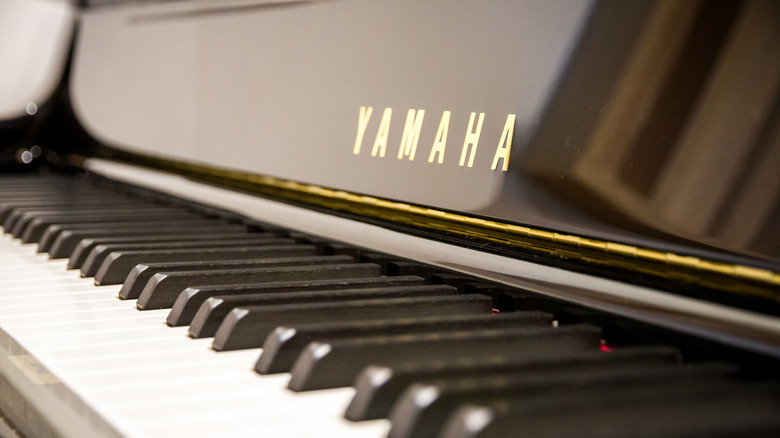Are Yamaha Motorcycles & Yamaha Musical Instruments Made By The Same Company?
Among auto enthusiasts, Yamaha is regarded as one of Japan's "Big Four" motorcycle manufacturers, alongside contemporaries like Honda, Suzuki, and Kawasaki. Of these four companies, Suzuki and Honda are predominantly focused on the automotive space (although Honda does have interests in aviation and robotics). Yamaha and Kawasaki, on the other hand, while pretty well known for their presence in the automotive space, also boast divisions that have nothing to do with automobiles. Kawasaki, for example, has teams specializing in heavy machinery, aerospace, and shipbuilding, thereby ending up with products that one does not usually associate Kawasaki with. Yamaha, outside of motorcycles, has a strong presence in the musical instruments and audio equipment space.
Given that the Yamaha logo is seen on objects as diverse as motorcycles and synthesizers, as well as AV receivers and speakers, people have often wondered if these seemingly different Yamaha products are manufactured by the same company. As it turns out, there is not only a strong connection between these Yamahas, but their histories are intertwined in more ways than one can think. Legally speaking, however, the two Yamaha brands — the one that manufactures motorcycles and the one that manufactures musical instruments — are separate entities.
The two companies that share the Yamaha name today include Yamaha Corporation (which owns the musical instruments, audio equipment, and allied businesses) and the Yamaha Motor Company (known for making Yamaha's much-loved motorcycles while also dabbling with marine engines, ATVs, and industrial robots).
Music first, motorcycles later: How Yamaha started with pianos
The Yamaha brand name was predominantly associated with music and musical instruments for a sizable part of its early history. The company was founded well over a century ago, in 1887, by Torakusu Yamaha. Initially (since 1889), the company was known as Yamaha Fukin Seizoujo before changing its name to Nippon Gakki Co., Ltd. in 1897. It's pertinent to note that although the company was officially known as Nippon Gakki Co., Ltd., its products were branded under the "Yamaha" name while also prominently displaying the company's famous tuning fork logo.
In 1955 — 68 years after Yamaha's founding — Nippon Gakki (loosely translated as "Japanese Musical Instruments") would finally enter the motorcycle business. The same year also saw Nippon Gakki spin off its new motorcycle division, which it would eventually call the Yamaha Motor Company, a name that would ultimately evolve into the motorcycle brand we know today. While the motorcycles division operated as the Yamaha Motor Company from day one, it would only be in 1987 — on the 100th year of Yamaha's founding — that the musical instruments division would forgo the old name Nippon Gakki Co., Ltd. and adopt its new name: Yamaha Corporation.
Since these two companies had become independent businesses serving entirely different markets but using the same "Yamaha" brand, they had to establish an agreement to govern how they would share and manage the name.
How Yamaha manages two brands with the same name
To ensure that the two separate Yamaha companies use the Yamaha logo and brand name responsibly, the companies have entered into a formal brand licensing agreement. According to the terms of this deal, both companies are permitted to use the Yamaha name and the iconic Yamaha tuning fork logo. The companies have also established a Joint Brand Committee, which meets regularly to coordinate decisions on how the name, logo, fonts, and other design elements should be used across advertisements, products, and events.
Both companies also follow a shared rulebook known as the Yamaha Brand Charter and Joint Brand Regulations. These documents outline exactly how each company can use the name and visuals, ensuring the brand remains strong and consistent, whether on a motorcycle fuel tank or a piano in a concert hall.
Interestingly, the logos themselves have distinct details. Yamaha Corporation's logo is violet, its corporate color, with the three tuning forks fully enclosed within a circle and the word "YAMAHA" printed in an asymmetric font — its "M" has a middle leg shorter than the sides. In contrast, Yamaha Motor's logo is red, the tuning forks extend outside the circle, and the "YAMAHA" text uses a symmetrical "M" with all three legs equal in length.
This joint brand charter helps both companies maintain a consistent reputation and avoid conflicts over how the Yamaha name is used. They also share the message — "Two Yamahas, One Passion" — to highlight that, despite making very different products, they operate under a common legacy and brand identity.


